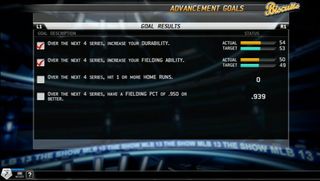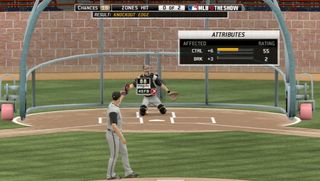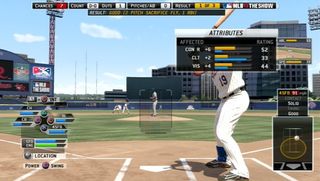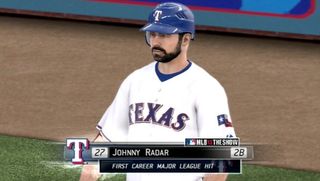
TRAINING/MEETING GOALS
There are two types of training in MLB 13: The Show. The first is the training you see on display in the main RTTS menu. It’s instant gratification for all your needs, and can be achieved by merely spending experience earned in game situations. The second is provided by various training mini-games you’ll encounter during the season itself. These happen at different intervals during the season, and are completely random. Unlike the first kind of training, you have no say in what kind of mini-game training your player will be allowed to take part in. The Show decides for you.
Training is tied to meeting your goals. During a set period (which varies from one week to a month), your coach will inform you of set of challenges you must meet. As a fielder, there will typically be two attribute-related goals and two statistical goals. As a pitcher, you can have up to three different attribute-related goals at once, but will mostly see the 2X2 goals fielders see as well. You don’t always have to meet these goals to make the team happy, however frequently missing out on these goals could result in reduced playing time. Additionally, meeting your goals often increases the chances you’ll advance higher up in the organization.

Experience is earned in playing games and in the mini-game training. However, the in-game experience is put into an open pool for you to use, while the mini-game experience goes directly to specific attributes the training exercise is geared towards. In an actual game, you won’t get graded on individual pitch performance, but for the overall result of an at-bat. If you hit a lot of singles, you’ll do okay. Ground out on the first pitch constantly, and you’ll be hurting. Unfortunately, much of the pitcher’s end results are tied to what the rest of the team does in the field. Striking out batters is the best result, but that can’t and shouldn’t happen every time you’re facing an opposing batter. If your team makes an error in the field, you won’t get as much experience. It’s disappointing, but the penalties are never too severe.
As for the mini-games, you’ll get out of them what you put into them. Take them seriously, and your attributes will grow tremendously. Skip them or screw around, and you’re likely to spend more time in the Minors.
Below you’ll find a list of the mini-games included in The Show, and which attributes they’ll help you boost.

Swing Timing: Contact, Vision, Power, Batting Clutch
Pitch Recognition: Vision, Contact, Power
Good At-Bat Training: Contact, Power, Batting Clutch, Discipline
Throw Decision: Arm Accuracy, Arm Strength
Fielding Reaction: Reaction
Batting Contact: Contact, Power
Discipline Training: Contact, Discipline, Vision, Power
Good Jump: Base-running Ability, Base-running Aggressiveness
Steal Third Base: Base-running Ability, Base-running Aggressiveness
Pitch Location: Control, Break/Movement, Pitching Clutch (specific to each pitch)
Pitch Type: Control, Break/Movement (specific to each pitch)
Simulated Game: Control, Break/Movement, Pitching Clutch
Knockout Training: Control, Break/Movement

Like a good coach, we hope we’ve given you everything you need to succeed on the way to your Hall of Fame career. It’s up to you to put these tools to good use though. Now get out there, and play ball!
TABLE OF CONTENTS
- Page 1: Introduction
- Page 2: Position Selection
- Page 3: Rating Your Potential
- Page 4: The Season
- Page 5: Gameday Tips
- Page 6: Training/Meeting Goals
